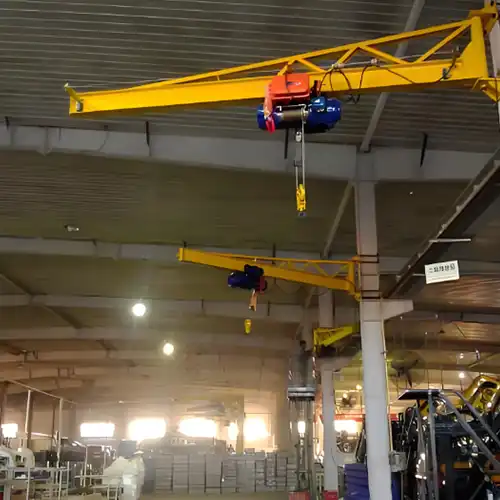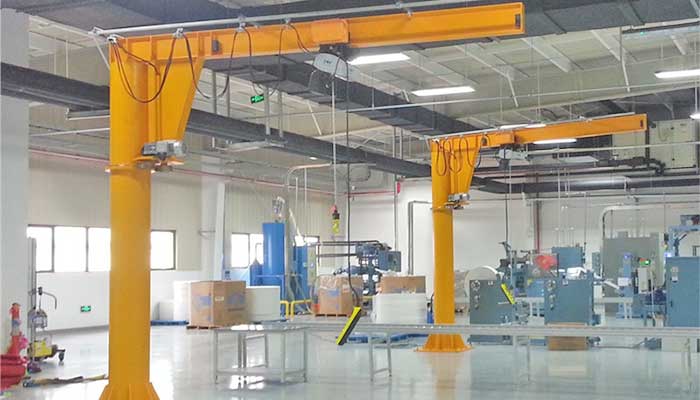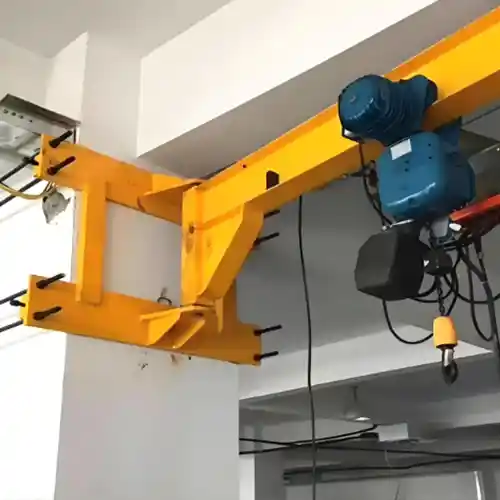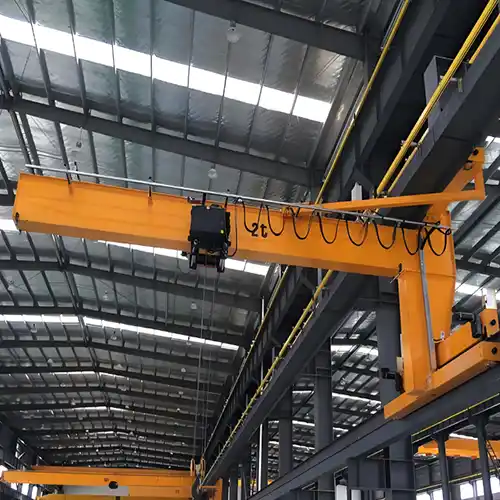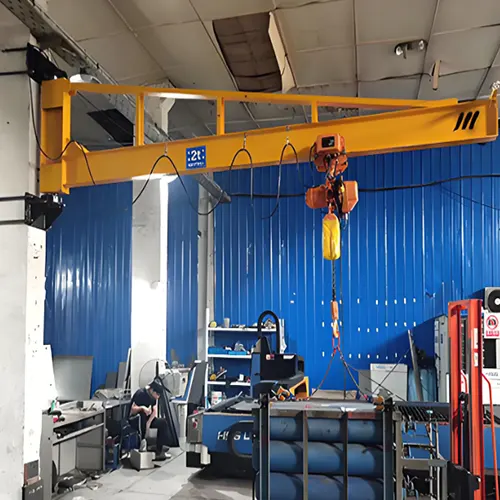Comparing Wall Mounted vs. Floor Mounted Jib Cranes: Which is Right for Your Facility?
A comparative analysis of wall-mounted and floor-mounted jib cranes, focusing on their advantages, limitations, and ideal applications in various industries.
Category: Wall Crane
Your Trusted Jib Crane Manufacturer & Supplier
Comparing Wall Mounted vs. Floor Mounted Jib Cranes: Which is Right for Your Facility?
A comparative analysis of wall-mounted and floor-mounted jib cranes, focusing on their advantages, limitations, and ideal applications in various industries.
Comparing Wall Mounted vs. Floor Mounted Jib Cranes: Which is Right for Your Facility?
Jib cranes are versatile lifting devices designed to handle various loads with precision and ease. They consist of a horizontal arm (the jib) that extends from a vertical mast, allowing the crane to lift and move objects within a specific radius. Jib cranes are highly valued for their ability to provide flexible, localized lifting solutions, making them ideal for environments where space is at a premium or where specific load handling is required.
The primary benefits of jib cranes include:
- Enhanced Mobility: The jib's rotational capability allows for efficient movement of loads within a designated area.
- Space Optimization: By focusing lifting operations in a confined area, jib cranes help maximize available floor space.
- Ease of Use: They offer straightforward operation, making them user-friendly for a variety of tasks.
- Cost-Effectiveness: Generally, jib cranes are less expensive than larger, more complex lifting systems, providing a budget-friendly option for many facilities.
Importance of Choosing the Right Type
Selecting the appropriate type of jib crane—wall-mounted or floor-mounted—significantly impacts your facility's efficiency and operations. The choice between these two types of cranes hinges on several factors:
- Space Constraints: Wall-mounted jib cranes are an excellent choice for facilities with limited floor space or where additional floor-standing equipment might be obstructive. In contrast, floor-mounted jib cranes require more floor space but offer greater flexibility in placement and movement.
- Load Handling Needs: The capacity and range of movement are crucial in determining which crane is suitable. Wall-mounted cranes might be limited by the strength of the wall and the reach of the jib, while floor-mounted cranes typically support higher loads and provide more extensive reach.
- Facility Layout and Structure: The choice also depends on the existing facility structure. Wall-mounted cranes depend on the strength of the mounting wall or column, whereas floor-mounted cranes are anchored to the floor and can be placed more freely within the workspace.
By carefully evaluating these factors, you can select a jib crane that best fits your facility's operational needs, enhancing productivity and ensuring efficient use of space and resources.

Wall Mounted Jib Cranes
Definition and Design
Wall-mounted jib cranes are fixed to a wall or vertical support, utilizing this structure to anchor the crane's vertical mast. The crane's jib extends horizontally from this mast, providing a range of motion within the crane's operational radius. This design allows for lifting and moving loads efficiently within a specific area without occupying floor space.
Key design features include:
- Horizontal Jib: The arm of the crane that extends outwards, allowing for a range of movement.
- Vertical Mast: Mounted securely to the wall, supporting the jib and ensuring stability.
- Rotational Base: Allows the jib to swivel, providing flexibility in load placement.
Advantages
- Space Efficiency: Wall-mounted jib cranes are particularly beneficial in environments where floor space is at a premium. By utilizing existing walls or columns, these cranes free up valuable floor area, making them ideal for smaller facilities or areas with limited floor space. This configuration helps in maintaining an organized and clutter-free workspace.
- Cost-Effectiveness: The initial investment and installation costs for wall-mounted jib cranes are generally lower compared to floor-mounted options. This is because wall-mounted cranes do not require additional foundation work or extensive floor anchoring. Their installation primarily involves securing the crane to an existing wall or column, which often translates to reduced costs in both equipment and labor.
- Ease of Installation: Installing a wall-mounted jib crane is relatively straightforward. It involves attaching the vertical mast to a suitable wall or column, which simplifies the installation process. This ease of installation can result in shorter setup times and less disruption to ongoing operations.
Limitations
- Load Capacity: The load capacity of wall-mounted jib cranes is limited by the strength of the wall or column to which they are mounted. Unlike floor-mounted cranes, which have independent supports, wall-mounted cranes rely on the structural integrity of existing building elements. This can restrict the maximum weight they can safely handle.
- Flexibility and Movement: Wall-mounted jib cranes typically offer less flexibility in terms of reach and rotation compared to their floor-mounted counterparts. The movement of the jib is constrained by the mounting structure, which can limit the crane's effectiveness in applications requiring extensive maneuverability.
- Structural Requirements: The installation of wall-mounted jib cranes depends heavily on the strength and suitability of the wall or column used for mounting. Not all walls or columns are designed to support the forces exerted by a jib crane, which means a thorough assessment of the existing structure is necessary to ensure safe and effective installation.
Ideal Applications
- Small to Medium-Sized Facilities: Wall-mounted jib cranes are well-suited for small to medium-sized facilities where floor space is limited. Industries such as automotive repair shops, small manufacturing units, and warehouses often benefit from the compact nature of wall-mounted cranes.
- Limited Space Environments: These cranes are particularly effective in confined or crowded environments where floor space is at a premium. For example, in areas with dense machinery or equipment, wall-mounted jib cranes can provide localized lifting solutions without further encroaching on the already limited floor area.
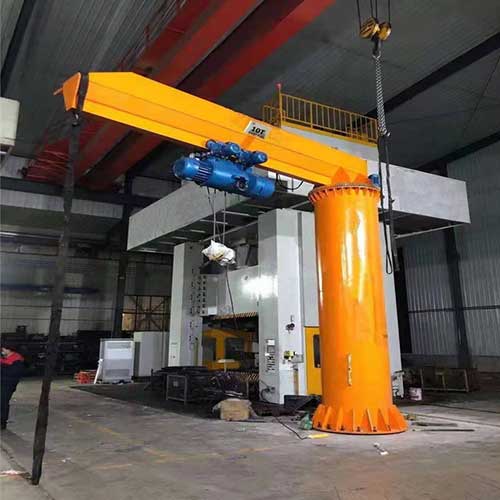
Floor Mounted Jib Cranes
Definition and Design
Floor-mounted jib cranes are supported by a base or foundation anchored directly to the floor, allowing the crane's vertical mast to stand independently. The jib extends horizontally from this mast, enabling a wide range of lifting and moving capabilities within its operational radius.
The design typically includes:
- Vertical Mast: Anchored securely to the floor, providing stable support for the jib.
- Horizontal Jib: Extends outward, allowing for horizontal movement of loads.
- Rotational Mechanism: The jib can rotate around the mast, offering extensive maneuverability and flexibility in load placement.
Advantages
- Higher Load Capacities: Floor-mounted jib cranes are capable of handling significantly heavier loads compared to wall-mounted models. Since they are supported by the floor rather than existing walls, they are not limited by the strength of a building's structure. This independent support allows for the lifting of larger and heavier items, making these cranes suitable for demanding industrial applications.
- Greater Flexibility: These cranes offer greater flexibility in terms of movement and reach. The jib's rotation and the crane's ability to be positioned precisely where needed provide a broader operational range. This increased maneuverability is beneficial in environments where the load needs to be moved over a large area or in complex configurations.
- Customizable Installation: Floor-mounted jib cranes can be installed in various locations within a facility without relying on existing structures. This flexibility allows for precise placement based on operational needs and can be tailored to specific requirements of the facility layout, improving workflow and efficiency.
Limitations
- Floor Space Usage: One of the primary drawbacks of floor-mounted jib cranes is their use of valuable floor space. These cranes occupy a portion of the floor area, which may interfere with other equipment or processes. In environments where space is constrained, this can be a significant consideration.
- Installation Complexity: The installation of floor-mounted jib cranes is more complex compared to wall-mounted models. It often requires the construction of a foundation or anchoring system to support the crane's base. This can involve additional costs and time for installation, as well as potential disruption to existing operations.
- Initial Investment: Floor-mounted jib cranes generally come with a higher initial cost than wall-mounted versions. This is due to the need for a robust foundation and the additional materials and labor required for installation. The upfront investment must be weighed against the crane's capacity and operational benefits.
Ideal Applications
- Large Facilities: Floor-mounted jib cranes are particularly well-suited for large facilities where there is ample floor space available. Industries such as heavy manufacturing, automotive assembly, and large warehouses benefit from these cranes due to their capacity for handling significant loads and providing flexible movement.
- Heavy-Duty Applications: These cranes are ideal for applications that require handling heavy or bulky loads. Their robust design and higher load capacities make them suitable for heavy-duty tasks in industries like steel production, construction, and large-scale fabrication, where strength and flexibility are crucial.
Comparative Analysisnes.
Load Capacity and Performance
When assessing the load capacities and performance of wall-mounted versus floor-mounted jib cranes, it is crucial to understand the distinct characteristics and limitations of each type:
Wall-Mounted Jib Cranes
Wall-mounted jib cranes are designed to be anchored to existing walls or columns. Their load capacity is inherently limited by the strength of the supporting structure. Key points include:
- Load Capacity: These cranes typically handle lighter to moderate loads. The load capacities usually range from 500 kg to 2 tons, depending on the strength and stability of the wall or column to which they are attached. This limitation arises because the wall or column must bear both the load being lifted and the forces generated by the crane's operation.
- Performance: The operational performance of wall-mounted jib cranes is influenced by the structural capacity of the wall and the length of the jib. The reach of the jib is constrained by how far it can extend without compromising the crane's stability. Additionally, the rotation of the jib may be limited by the proximity of other structures or the wall itself, potentially restricting the crane's effective operational radius.
Floor-Mounted Jib Cranes
Floor-mounted jib cranes, supported by a base or foundation anchored directly to the floor, offer several advantages in terms of load capacity and performance:
- Load Capacity: These cranes are capable of handling significantly heavier loads compared to wall-mounted models. Load capacities for floor-mounted jib cranes can reach up to 5 tons or more. This higher capacity is due to the independent support provided by the floor, which is generally better suited to bear substantial loads without being restricted by existing structural elements.
- Performance: Floor-mounted jib cranes offer enhanced performance due to their greater reach and rotational flexibility. The independent support structure allows for a more extensive operational range, enabling the jib to extend further and rotate more freely. This increased flexibility makes floor-mounted cranes ideal for heavy-duty applications where substantial load handling and versatile movement are required.
In summary, the choice between wall-mounted and floor-mounted jib cranes should be guided by the specific load requirements and the desired performance characteristics. Wall-mounted cranes are suitable for lighter loads and space-constrained environments, while floor-mounted cranes are better suited for heavier loads and applications requiring greater flexibility and reach.
Space and Facility Requirements
The choice between wall-mounted and floor-mounted jib cranes can significantly impact the layout and space utilization of your facility. Here's how each type affects space and operational efficiency:
Wall-Mounted Jib Cranes
- Space Efficiency: Wall-mounted jib cranes are designed to attach directly to existing walls or columns, which helps conserve valuable floor space. This feature is particularly advantageous in facilities where space is limited or where equipment is densely arranged. By utilizing vertical surfaces for support, these cranes free up floor area for other uses, making them ideal for compact environments such as small workshops, narrow aisles, or facilities with heavy equipment.
- Operational Constraints: Despite their space-saving advantages, wall-mounted cranes have limitations in operational flexibility. The reach and movement of the jib are constrained by the position and strength of the wall or column to which it is attached. This can limit the crane's effectiveness in moving loads to certain areas of the facility, particularly if the wall or column is not ideally situated for the required operational range.
Floor-Mounted Jib Cranes
- Floor Space Usage: Floor-mounted jib cranes require a dedicated footprint on the floor for their base or foundation. This setup can influence the overall facility layout by occupying floor space that might otherwise be used for other purposes. The need for clear space around the base for installation and operation means that these cranes can potentially interfere with the placement of other equipment or workflow areas.
- Layout Flexibility: On the positive side, floor-mounted jib cranes offer greater flexibility in terms of placement. They can be installed in various locations within the facility, allowing for optimal positioning based on operational needs and workflow. This adaptability is particularly beneficial in larger facilities where there is sufficient floor space and the ability to reconfigure layouts as operational requirements evolve. The ability to position cranes precisely where needed can enhance overall efficiency and productivity.
In summary, wall-mounted jib cranes are advantageous for facilities with constrained floor space, offering a space-saving solution while working within the limitations of wall or column support. Floor-mounted jib cranes, while requiring more floor space, provide greater flexibility in placement and operational range, making them suitable for larger or more adaptable facilities. The choice between these crane types should align with your facility's space constraints and operational needs.
Cost Considerations
When evaluating the costs associated with wall-mounted and floor-mounted jib cranes, it is essential to consider several financial aspects, including initial investment, installation, maintenance, and long-term value. Here's a breakdown of the cost factors for each type:
Wall-Mounted Jib Cranes
- Initial Cost: Wall-mounted jib cranes typically have a lower initial cost compared to their floor-mounted counterparts. This is due to their simpler installation process and fewer material requirements. Since these cranes attach to existing walls or columns, they often require less structural work and fewer components. However, costs may vary depending on the condition and suitability of the wall or column, as any necessary reinforcement or modifications can increase the overall expense.
- Installation Costs: The installation of wall-mounted cranes is generally straightforward, involving mounting the crane to a pre-existing structure. This simplicity usually translates into lower installation labor costs and reduced disruption to facility operations.
- Maintenance Costs: Maintenance for wall-mounted jib cranes tends to be lower because of their less complex design and fewer moving parts. Regular upkeep involves checking the attachment points and the crane's operational components, but overall maintenance is typically less demanding compared to floor-mounted cranes.
- Long-Term Value: The long-term value of wall-mounted jib cranes depends on their load capacity and how effectively they utilize available space. While they offer cost savings in initial investment and maintenance, their performance is limited by the wall or column's structural capacity, which may impact their efficiency over time.
Floor-Mounted Jib Cranes
- Initial Cost: Floor-mounted jib cranes generally involve a higher initial investment. The need for a strong foundation or base, along with more extensive installation work, contributes to the increased cost. This includes materials for the base, installation labor, and potential modifications to existing operations or floor space.
- Installation Costs: Installing floor-mounted cranes is more complex and may require significant groundwork or alterations to the facility. The need for a robust foundation and careful alignment adds to the installation costs and may cause temporary disruptions to existing workflows.
- Maintenance Costs: Maintenance for floor-mounted jib cranes can be higher due to their more complex design and the additional structural components involved. Regular maintenance includes checking the foundation, crane mechanisms, and ensuring that all components are functioning correctly. Despite this, the maintenance needs are manageable with proper care and regular inspections.
- Long-Term Value: Floor-mounted jib cranes often offer greater long-term value due to their higher load capacities and flexibility in operation. Their ability to handle heavier loads and provide more extensive movement can enhance operational efficiency and adaptability, which may outweigh the higher initial and maintenance costs.
In conclusion, wall-mounted jib cranes are generally more cost-effective in terms of initial investment and maintenance but may be limited by structural constraints. Floor-mounted jib cranes involve higher initial and maintenance costs but offer superior load capacities and flexibility, potentially providing greater long-term benefits and efficiency. The choice between the two should be based on balancing initial costs with operational needs and long-term value.
Installation and Maintenance
The installation and maintenance of wall-mounted and floor-mounted jib cranes each come with their own set of requirements and complexities. Here's a detailed comparison:
Wall-Mounted Jib Cranes
- Installation: Installing wall-mounted jib cranes is relatively straightforward. The process involves securely attaching the vertical mast to an existing wall or column using brackets or mounting plates. This simplicity generally results in lower installation costs and shorter setup times compared to floor-mounted cranes. However, it is crucial to ensure that the wall or column is structurally sound and capable of supporting the crane's weight and the loads it will handle. The installation team must assess the wall's strength and may need to reinforce it if necessary to ensure safety and stability.
- Maintenance: Maintenance for wall-mounted jib cranes is typically less complex due to their simpler design and fewer structural components. Regular maintenance mainly involves inspecting the attachment points, checking the jib's operational mechanisms, and ensuring smooth movement. Since wall-mounted cranes have fewer moving parts and less complex structural elements, maintenance tasks are generally less frequent and less labor-intensive. However, attention must be given to the condition of the supporting wall or column to prevent any potential issues.
Floor-Mounted Jib Cranes
- Installation: The installation of floor-mounted jib cranes is more involved and requires constructing a robust foundation or anchoring system. This foundation supports the crane's base and ensures stability during operation. The process is time-consuming and can be costly due to the need for extensive groundwork and potential modifications to the facility. Additionally, the installation may cause temporary disruptions to existing operations as the area around the installation site may need to be cleared or modified.
- Maintenance: Maintenance for floor-mounted jib cranes can be more complex due to their additional structural components, including the foundation or base. Regular maintenance tasks include inspecting the foundation for any signs of wear or damage, ensuring the crane's mechanical parts are functioning correctly, and checking for any structural issues that may affect performance. In high-load applications, maintenance becomes crucial to ensure that the crane operates safely and efficiently. Regular inspections and upkeep are essential to prevent potential issues and maintain the crane's performance over time.
In summary, wall-mounted jib cranes offer easier and less costly installation and maintenance due to their simpler design and reliance on existing structures. However, they require careful assessment of the wall or column's strength. Floor-mounted jib cranes involve more complex and costly installation due to the need for a foundation and may have higher maintenance demands due to their additional structural components. Choosing between the two types should consider the implications of installation and maintenance on overall operational efficiency and cost.
Conclusion
In summary, wall-mounted and floor-mounted jib cranes offer distinct advantages and limitations that cater to different operational needs:

Floor-Mounted Jib Cranes

Wall-Mounted Jib Cranes
Wall-Mounted Jib Cranes: These cranes are designed to be mounted on existing walls or columns, making them ideal for facilities with limited floor space. They generally have lower load capacities and less flexibility in reach and movement due to their reliance on wall strength. Their installation is simpler and more cost-effective, but their performance is constrained by the supporting structure.
Floor-Mounted Jib Cranes: These cranes are supported by a base anchored directly to the floor, allowing them to handle heavier loads and offer greater flexibility in movement and placement. They require more floor space and a more complex installation process, involving the construction of a foundation. While they come with a higher initial investment and potentially greater maintenance costs, their enhanced capacity and flexibility make them suitable for more demanding applications.
Choosing the Right Crane for Your Facility
When deciding between wall-mounted and floor-mounted jib cranes, consider the following factors:
- Facility Size: Evaluate the amount of available floor space. Wall-mounted cranes are ideal for smaller or more cluttered facilities, while floor-mounted cranes are better suited for larger areas where space is less of a constraint.
- Load Requirements: Assess the maximum load your operations require. For heavier loads or more intensive lifting tasks, floor-mounted cranes offer superior capacity and performance. Wall-mounted cranes are better for lighter loads and applications where space efficiency is crucial.
- Budget: Consider both initial investment and long-term costs. Wall-mounted cranes generally have a lower initial cost and simpler installation, while floor-mounted cranes require a higher upfront investment but may provide better long-term value with their higher capacity and flexibility.
Recommendations for Specific Applications
- Small to Medium-Sized Facilities: If you operate in a confined space or have limited floor area, a wall-mounted jib crane may be the best option. It is particularly suitable for environments such as small workshops, automotive repair facilities, or warehouses where space is at a premium.
- Heavy-Duty Applications: For facilities that handle heavy or bulky loads, such as large manufacturing plants, steel fabrication shops, or heavy-duty assembly lines, a floor-mounted jib crane is recommended. Its ability to handle higher capacities and provide greater flexibility makes it well-suited for these demanding applications.
- Flexibility and Expansion Needs: If your facility requires the ability to easily reposition the crane or expand operations in the future, a floor-mounted jib crane offers more flexibility in terms of placement and movement. This type of crane can be installed in various locations and adjusted as operational needs evolve.
Choosing the right jib crane involves balancing your facility's specific requirements with the advantages and limitations of each crane type. By carefully evaluating these factors, you can select the crane that best enhances your operational efficiency and meets your lifting needs.
Related Products

Latest project
150 Ton Overhead Crane Installation Feedback – Paraguay Case
QDX 150 ton overhead crane in action in Paraguay. Installation photos, video, and client feedback show performance, safety, and heavy-lifting efficiency.
Free consultation to Confirm Parameters & Specifications and Get
Latest Crane Price & Crane Rate.
- Types of overhead cranes : _______?
- Optional: Overhead travelling crane, goliath gantry crane,Slewing jib crane, Single girder or double girder crane,small portable crane or kbk crane, etc.
- Capacity of overhead crane: _______?
- Optional: 0.25ton, 0.5 ton, 1 ton, 2 ton, 3ton, 5 ton, 10 ton,15ton, 20ton, 25 ton, 30ton,35ton, up to 550ton, etc.
- Crane span & lifting height : _______?
- Crane travelling length : _____?
- Control of overhead crane:_______?
- Optional: pendant/ remote/cabin control
- Voltage supply of overhead crane:_____?
- Eg,: 380V50/60HZ,3Phase or others,etc.
- Application/usage of crane:_______?
- Eg,: Steel mill, ,injection mold, cement,stone, concrete,granite, general manufacturing, etc.
Just leave a message via the contact form and our hoist and crane engineer will contact you with in 24working hours.
Get In Touch
